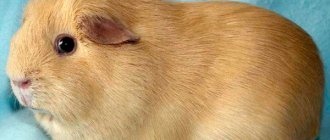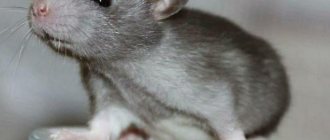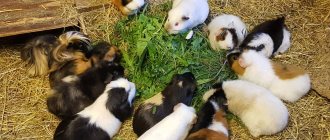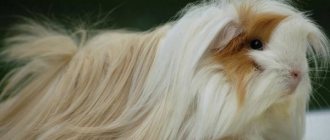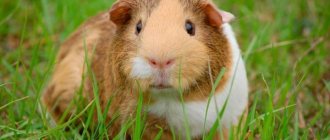The guinea pig (lat. Cavia porcellus) would probably be very surprised if she learned about its Russian-language name, because it has nothing in common with either real pigs or the sea. Then why is it called that way?
flickr/pyza*
Everything is very simple: it became “marine” because it was brought from America, i.e. from across the sea. Although it would probably be more correct to call it “overseas”. In Europe, it is most often called "Guinea pig", "pig mouse" or "Indian pig". As you can see, only the word “pig” does not cause controversy. Why? Because this animal sometimes makes grunting sounds, just like its big namesake.
The Andean tribes of South America were the first to domesticate guinea pigs 5 thousand years ago. True, then they were not just pets. People used them as a source of tasty meat or as sacrifices for various rituals and ceremonies. Since the 13th century AD. Indian tribes became seriously interested in breeding them and, before the conquest of the Inca Empire in 1533, managed to develop many different breeds.
flickr/pyza*
Of course, modern breeders have gone even further. Today there are a huge number of varieties of guinea pigs that are completely different from each other. For example, in pet stores you can find both long-haired animals, as well as wire-haired, short-haired and even animals with no hair at all or with a little fluff.
In general, guinea pigs have a body length of 25 to 35 cm, they have a wide blunt muzzle with floppy ears, a large body with rounded shapes and no tail at all. Males weigh from 1 to 1.5 kg, females - from 0.8 to 1.2 kg. In wild individuals, the natural color of the upper body is brownish-gray, the belly and the inside of the paws are lighter.
flickr/pyza*
These are quite cute pets with a good-natured and trusting character. They love to sit in their arms and play with their owner. However, during such activities you should be very careful, since a fall even from a small height can have very sad consequences for the animal.
Interestingly, guinea pigs, in addition to grunting, can make many other different sounds. For example, when they are happy, they may purr. Males sometimes purr when courting. Females, during pregnancy or in the absence of a male, begin to chirp like birds. They do this at night, continuing their “song” from 2 to 10 minutes. True, this happens extremely rarely.
flickr/pyza*
Guinea pigs eat hay, grain feed, juicy vegetables and fruits. When feeding, it should be taken into account that fresh hay should be kept in the cage around the clock, since the animal uses it to grind down its teeth, in addition, it helps to normalize the functioning of the digestive system.
Sometimes the animal can be caught in a not very pleasant procedure - eating its own droppings. He inherited this habit from his wild ancestors - it turns out that in this way guinea pigs are enriched with vitamins, since vitamins B and K are absorbed in the animal’s body only when they repeatedly pass through the gastrointestinal tract.
It is better to keep them in pairs or small same-sex groups - loneliness makes guinea pigs very worried, which leads to overeating and a shortened lifespan.
So…
How a rodent received the “title” of artiodactyl
First, let's look at the origin of the name “pig”.
When the Spanish conquistadors reached the homeland of future pets (the Andes in South America), the local population bred rodents as livestock (in other words, “for meat”). And it is not surprising that they were first seen in the form of a dish. The carcass of the animal really resembles a suckling pig. This is where the name “pig” comes from. This is the most realistic version of the appearance of the name.
By the way, in Peru you can still find Cui (the local name for guinea pig) on the menu of catering establishments, although this is not as common as in the time of Columbus.
Description of the rodent
— Advertising —
The body length of a guinea pig is 25-35 cm depending on the breed, the body is round in shape, there is no tail, the ears are hanging, the muzzle is wide and blunt. The weight of an adult male ranges from 1 to 1.5 kg, the female usually weighs a little less, from 800 to 1200 g. The natural color of the guinea pig is brownish-grayish, the tummy and paws are light on the inside.
Additional versions of the name appearance
Even when alive, a guinea pig looks like a piglet, except that it has no heel:
- Disproportionately large head
- Droopy ears
- Short legs
- The shape of the body is similar to that of a pig
On the other hand, if people named newly discovered animals after already known ones, then there would be big problems with diversity. Therefore, the version is doubtful.
A more plausible theory states that the animal is so named because of the sounds it makes. When the pet is happy, it grunts - very similar to a young pig. And when scared it makes a pig-like squeal. Based on these analogies, the name appeared.
Yes, in this form the similarity is obvious.
A pet
Guinea pigs have long become perhaps the most familiar inhabitants of a living area.
They are very peaceful and fun to watch. Experts recommend keeping these animals in families (3 females and 1 male). You can have one animal, but then the owner must communicate with his pet more often, otherwise he will get bored. For several animals you need a fairly large cage, since each one needs a space of 40x40 centimeters. Cages with a deep plastic tray and a top made of metal rods are convenient. Sawdust or hay is placed in the tray as bedding. Guinea pigs produce a lot of urine, so bedding needs to be changed more often. The cage should be placed where there are no drafts, otherwise the pigs will often catch colds. They definitely need to build a house to sleep in. Every day the animals should be given the opportunity to run freely around the apartment. From lack of movement, they grow long claws, which, growing into the pads, cause pain. Pigs will feel comfortable in a house at a temperature of 16-18°C and a relative air humidity of 50%. If in the summer you can take your pet out onto clean country grass and give him the opportunity to graze, he will be very grateful to you.
How a pig became a guinea pig
We've sorted out the pig-likeness, but what about the sea? Not only do guinea pigs not swim, but they also don’t like water.
The simplest explanation here is that the ancestors of modern domestic animals were brought from overseas. So they called them overseas, sea. The same name for rodents in Polish and German.
This theory is partially confirmed by the name Guinea pig, because. in those days in England, everything that was imported from overseas was called “Guinean”.
This requires some clarification: Guinea is in West Africa, and the Kui originated from South America. Here, as in the entire history of overseas rodents, there are no simple answers. The most common explanations are:
- The word "Guinean" was used to mean "overseas"
- Guinea is similar to Guiana (a French colony in South America), so there was confusion
- Guinea pigs initially cost exactly 1 guinea (English coin), hence the nickname.
Nutrition
The basis of the diet is hay (about 80%). Since hay may contain dust, it is better to serve it to the animal in a special hay dispenser, which you can make yourself or buy at a pet store.
By the way, hay should not be gray in color: rotten or moldy hay is unsuitable for food. You can avoid this by not pouring water into a regular bowl; use a special water bowl for rodents. Of course, it is worth giving additional fruits and vegetables, grains, bran, as well as feed additives sold in pet stores. And remember that these rodents cannot produce vitamin C, so they need berries and fruits high in vitamin C. This includes:
- oranges
- lemon zest
- parsley
- broccoli
- kiwi
- bell pepper
- Brussels sprouts
- water with rosehip infusion (periodically)
It is recommended to feed this cute rodent three times a day and change the water daily to prevent it from stagnating.
But these animals also have prohibited products :
- any meat
- onion and garlic
- any conservation
- beans and firm peas
- corn
- beet
- hot peppers
- Potatoes are poisonous!
- nuts (high in fat)
- sunflower seeds (also have a lot of fat)
- avocado
- milk (pigs are lactose intolerant)
- cheese or cottage cheese (too fatty, contains lactose)
- anything containing industrial sugar (chocolate, cookies, etc.)
- all salty foods (salt crackers and bread)
And remember that all vegetables suitable for pigs cannot be boiled. Give vegetables raw. It is ideal to feed by the hour, since rodents in this regard are similar to most people and wait for food at the same time. What else should we not forget? There should be hay in the guinea pig's house at all times, fruits should be given about three times a week, vegetables - 200 grams every day for each animal. Additionally, it is permissible to give out a handful of granulated food daily.
Interesting facts about guinea pig breeding
Any breeding of animals should be taken seriously and should be done by experienced breeders. This activity is definitely not suitable for children or teenagers, since in case of complications, the pig will need to be urgently taken to the veterinarian and paid for a medical examination. It is important to remember that too many guinea pigs are left homeless simply because they have been the victims of inexperienced owners.
The duration of pregnancy for guinea pigs is 60 - 70 days. During pregnancy, the animal needs to be fed up to four times a day. Females are allowed for breeding only at the age of 4 - 5, if possible 6 months, and males - 6 - 7 months. Labor usually lasts within 30 minutes. It is difficult to predict the number of cubs, because from 1 to 6 individuals can be born. After giving birth, the mother pig eats the babies' placenta and licks them thoroughly so that they do not freeze. In the wild, this is an important protective instinct to avoid attracting predators who can smell blood well from a great distance.
The little cubs are born with their eyes open, completely covered in fur, and can stand on their feet within an hour of birth. In the first days, babies feed on mother's milk, but after 4 - 5 days they can already eat adult food (some even earlier), alternating it with mother's milk during the first three weeks of life. And although pigs are already sexually mature by three months, they fully grow within a year.
How long do guinea pigs live?
With good care, guinea pigs live 6 - 8 years . It is worth saying that some individuals can live up to 10 years . The oldest guinea pig named Snowball (from England) was registered and entered the Guinness Book of Records in 1979, having lived to almost 15 years. If you take into account all the advice, apply the recommendations on the correct maintenance of a guinea pig, and also treat it in a timely manner, then your pet will delight you with its presence for a long time and will give you and your family many pleasant emotions.
Version of the priests' conspiracy
In an attempt to circumvent the restrictions on eating meat during Lent, Catholic priests came up with all sorts of things. So cavy (another name for our pets) was included in seafood.
Of course, it was difficult to do this unnoticed. Therefore, they came up with the following reason: cavy were imported along with capybaras (rodents with a semi-aquatic lifestyle). On this basis, the priests classified pigs as... fish. And they decided to call them sea - to explain their actions.
The story may seem crazy, but many foods from the New World bypassed the prohibitions on consumption during Lent. For example, cocoa, although it can hardly be considered an abstinence food.
Bibliography[edit]
- Janet Vorwald Doner, Encyclopedia of Historic and Endangered Livestock and Poultry Breeds
, Yale University Press, 2001,
sv
"Guinea Hog" ISBN 0-300-08880-9 - R. A. Donkin, "Bakers: with observations on the introduction of pigs to the New World", Proceedings of the American Philosophical Society
, American Philosophical Society, 1985 ISBN 0-87169-755-6. - W. G. Kirk, "Pig Raising in the Southeast", Journal of Animal Science
,
1936b
, pp. 103–106, American Society of Animal Science, 1936. - Gary Paul Nabhan, Deborah Madison, Makale Faber, Ashley Rood, Renewing America's Food Traditions: Preserving and Preserving the Continent's Most Endangered Foods, Chelsea Green Publishing, 2008 ISBN 1-933392-89-4.
The simplest explanation
The simplest explanation for the origin of the name “guinea pig” is that the first sailors who reached the animals’ habitats adopted the experience of breeding them from the local Incas. And on the return trip they were taken to the ship (usually “standard” European pigs were taken on the trip and kept in a pen in the hold).
Rodents are friendly, can eat dried vegetation, do not take up much space, and produce much less waste. So they replaced the usual grunts on the Spanish ships. The name, based on the circumstances, is the most logical.
But everything changed upon arrival in Europe. There were few animals left, they were highly valued (as a curiosity), and it was more profitable to sell the remaining animals instead of using them for food. This is how the food animals migrated from the galley to the living rooms of aristocrats.
The owner calls him a pig so often that it’s better to hide before the New Year.
Reproduction
Preparing for pregnancy
Despite the fact that the animals reach sexual maturity early, experts recommend breeding them at the age of at least 10 months. When choosing a pair, give preference to individuals of the same breed and age category. Future parents should not be related. Obese individuals should also be excluded. A week before the expected mating, increase the amount of vitamin E in the animals’ diet.
It is advisable to plan a future pregnancy so that fertilization takes place no later than November, then the female will have time to feed her offspring before the spring molt. Otherwise, the combination of lactation and molting can be disastrous for the female, weakened after pregnancy. For the same reason, it is not recommended to cover females more than three times, and rare breeds that are difficult to care for and breed, twice a year.
Estrus in guinea pigs lasts 2 days and repeats every 12 to 20 days. The most favorable period for fertilization is the first 12 hours. It is not difficult to notice the pig’s readiness to become a mother; she takes a characteristic pose: she raises her back, spreading her legs and standing motionless. Males are almost always ready to mate.
The fertilized guinea pig is placed in a separate cage. If the next heat does not occur, then this indicates pregnancy, which will last about 10 weeks. Multiple pregnancies may result in earlier births.
Toxicosis in guinea pigs
So-called toxicosis can become a big problem during pregnancy. This is a painful condition that is typical for many individuals in the last weeks of pregnancy or the first days after childbirth. Often this condition leads to the death of the animal. Manifestations of toxicosis:
- Muscle cramps.
- Loss of appetite or complete refusal to eat.
- Profuse drooling.
- Tousled, dull fur.
The causes of toxicosis are poor nutrition, lack of water or vitamins, stress or multiple pregnancy. It is necessary to isolate the pregnant female from all these factors and provide her with special care.
Caring for a pregnant female
- Calm walks 1 – 2 times a day.
- Stable temperature and humidity in the room.
- in a cage with an area of at least 1200 - 1500 cm2.
- No stress - it is not recommended to handle the pig (it can cause miscarriage), pet it, or clean the cage often or for a long time.
- A varied diet - in the first half of pregnancy, the feed rate is increased by 1/3, in the second half - by 2 times.
- In addition to drinking water, they offer rosehip infusion, milk and tomato juice.
- Mineral and vitamin supplements in food (according to the recommendation and dosage of a veterinarian).
- Installation of a house in a cage with a nest made of fresh hay.
- For hygiene purposes, long-haired females need to be trimmed a few days before giving birth.
Childbirth and baby care
Childbirth is usually quick and uneventful, lasting no more than 30 minutes. Newborns are born sighted, hearing and with developed incisors. Weight ranges from 50 to 140 g. A litter contains on average 3 – 5 individuals. The cubs grow quickly, and on the 2nd - 3rd day they begin to eat food familiar to adults. By one month they become full-fledged guinea pigs, which can be separated from their mother.
It may happen that the mother dies during childbirth or after it from toxicosis. Then the best option would be to place the offspring with another female, since it is better for the babies to be among relatives. It is usually possible to feed orphans with diluted dry cream from a pipette. Be sure to provide the little ones with access to eat the droppings of adult pets. If by the 17th – 20th day of life the weight of the cubs has doubled, then we can assume that they are saved and are developing normally.
Unfortunately, non-viable babies born weighing up to 40 grams must be disposed of immediately. It is almost impossible to get out of them and, even if possible, the individuals will be too weak and sickly to live a full life.
Other names for guinea pigs
We have already mentioned the names Kavi (Kavi, Kavia), Kui, Guinean - in different countries the animal is called differently. It remains to remember that they haven’t named it yet.
The official scientific name in Latin is Cavia porcellus. The first part is derived from the local name of the animals. The second literally means “pig”.
In the UK the most common name is Indian pig. In Spain - Indian rabbit. This is due to the fact that open America has long been considered India. In some Western European countries, the pig is called Peruvian.
Modern guinea pigs
Today's pets are very different from their wild ancestors. In nature, Cavias are brown with a slightly lighter belly. “Home” colors are much more fun: black, white, red, pearl, two-color, three-color... Almost any.
According to the type of wool there are:
- Longhair
- Shorthair
- Wirehaired
- Hairless
You can read more about the breeds in a separate article on our website.
There is a color to suit every taste.
Links[edit]
- "Livestock Protection". livestockconservancy.org
. Retrieved March 10, 2022. - Kirk, p.103.
- "AHA".
- ^ a b Doner, 2001.
- ^ a b "Protection of livestock". livestockconservancy.org
. - Nabhandr., p.74.
- Nabhan and Dohner 2001 - 1991, although on the official website of the Association it is 2005.
- "Ark of Taste: Guinea Pig". Slow Food USA.
- “American Guinea Pigs | Lincoln Park Zoo". www.lpzoo.org
. - Malagon, Elvia. "Chicago man, self-described Satanist, loses final battle to remove 'In God We Trust' from US money". chicagotribune.com
.
